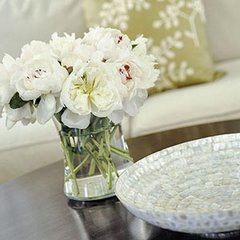
Contemporary style use straight lines, sculptural elements, art, and bold color. If you love clean, spare, and unique design, this may be the style for you.
Simplicity, subtle sophistication, texture and clean lines help to define contemporary decorating. It is a blend of comfortable, livable elements that create a sophisticated, fresh feel.
Here are some basic rules for you:
Color—Neutrals, black, and white are the main colors in contemporary interiors. The palette is often punched up and accented with bright and bold color. Black is often used to ground and define a contemporary room. With walls painted in a basic neutral, you have a wonderful backdrop for bold colored accessories.
Line and Space--The most obvious and distinctive element of a contemporary style is line. It's found in architectural details, use of bold color blocks, high ceilings, bare windows, and geometric shapes in wall art and sculpture. The bare space, on walls, between pieces of furniture, and above in upper areas, becomes as important as the areas filled with objects.
Contemporary Furniture--Smooth, clean, geometric shapes are essential for furniture pieces. Upholstered furniture often wears black, white, or other neutral tones in textured natural fibers. Cover it in a neutral, black, or bold fabric. Fabrics often have a natural look.
Furniture pieces should be simple and uncluttered, without curves or decoration. Sofas, chairs, and ottomans have exposed legs. Beds and chairs usually have no skirt, trim, fringe, or tassels.
Floors-- Should be bare and smooth in wood, tile, or vinyl. If you must use carpet for sound control or warmth, add color and texture with plain or geometric-patterned area rugs.
By focusing on color, space, and shape, your contemporary home can be a quiet and comfortable retreat.







